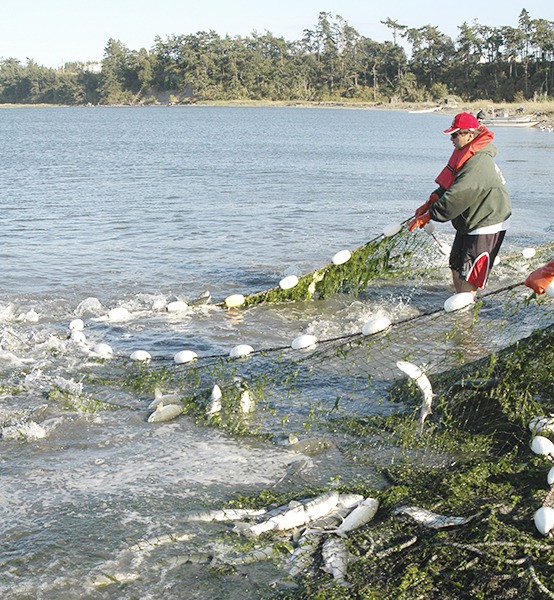The number of pink salmon returning to the Dungeness River in search of spawning grounds are defying historic records and thus allowing for a unique fishery opportunity in Dungeness Bay.
The Jamestown S’Klallam Tribe received approval from the National Oceanic and Atmospheric Administration and the other co-managers to conduct a beach seine fishery near the mouth of the river within Dungeness Bay mid-July through Aug. 22.
“We haven’t had a fishery for pink salmon in Dungeness Bay in more than 30 years because their numbers are typically a lot lower than they are this year,” Aaron Brooks, fisheries management biologist for the Jamestown S’Klallam Tribe, said.
But this year is proving to be different as both tribal and state officials estimated between 1.1 and 1.3 million pinks to return to the river. Given the unprecedented 2015 forecast, Brooks worked with his co-managers with the Port Gamble S’Klallam Tribe and the Point No Point Treaty Council to get a pink salmon beach seine fishery under way.
“We wanted to give tribal citizens the chance to harvest some of these fish,” he said. “In the 1960s there was a large estimate, but the annual average is about 40,000.”
Large forecast
Pink salmon return every odd year and because more than 400,000 fish returned in 2013 and about 29 million smolts were recorded leaving the river in 2014, the number expected to return is relatively high.
Even in 2013 with more than 400,000 pinks, it was a big jump from the 2011 run of 27,400.
Why the number of pink salmon dramatically increased in 2013 isn’t exactly known, but Brooks said, a number of factors influence how many fish return, such as river and ocean conditions. Also, some of the pinks possibly could have been strays from other watersheds.
“Who knows whether this trend will continue,” Brooks said.
A beach seine is a technique using a large, weighted net set in a wide arc away from the shore and then pulled back to shore, bringing all the fish with it onto the beach where they can be harvested. A beach seine was chosen as the ideal technique because it has a low mortality rate in contrast to other techniques like gill netting, Brooks said.
The Dungeness River also serves as spawning grounds for a small run of summer chum and chinook salmon — a threatened species under the Endangered Species Act. To avoid negatively impacting any chinook or summer chum, officials with the tribe carefully monitor during every set.
“This is potentially a test fishery,” Brooks said. “This will help determine whether we can do this again.”
Based on the information gathered through monitoring, and if both the number of pinks remain high and the interest is there, the fishery may continue in future years.
Unlike the price for many other types of salmon, pink salmon only range between about 20-30 cents per pound. The lower costs associated with pinks make them less appealing to most fishermen because they need to be able to catch large quantities to offset their own expense and labor.
Still, “Every fish counts” and there is a market for them, but it’s been difficult to find buyers because the market is flooded, Brooks said.
Many of the pink salmon caught are canned or integrated into pet foods, but the fishery allows for some economic gain and provides tribal citizens with another opportunity for subsistence fishing or for future crab and halibut bait.
Low river flows and funding
Additionally, with the onset of a drought and low river flows, the river temperature and amount of dissolved oxygen are points of concern for fish trying to reach adequate areas to spawn.
“We’re concerned with DO (dissolved oxygen) and don’t want a million fish dying in the river,” Brooks said.
To help combat the low river flows and increase the chance for salmon to successfully spawn, the Jamestown S’Klallam Tribe is to receive $74,430 from the Washington Department of Ecology.
In collaboration with Washington Department of Fish and Wildlife, personnel with Jamestown S’Klallam Tribe’s Natural Resources Department are planning to acquire and install multiple temporary diversion dams in the Dungeness River to concentrate flow and help spawning salmon migrate upstream. Flows in the Dungeness River are 35 percent of normal.
“We’re moving quickly to support critical water supplies for communities, farmers and fish across the state who are enduring extreme hardships in this unprecedented drought,” Maia Bellon, director of the Washington Department of Ecology, said.
The funding granted by DOE is one of three drought-relief projects recently supported by the state agency and originates from $16 million allocated by the 2015 Legislature to use over the next two years to help address drought-related hardships.
Through the grant program, public entities such as cities, public utilities and irrigation districts can get help paying for developing alternative water supplies or deepening existing groundwater wells.
More applications for grant funding have been received and DOE officials are reviewing the applications. The agency expects to fund more drought-relief projects in the coming weeks. The entire state became eligible for drought relief funding after Gov. Jay Inslee declared a statewide drought May 15



